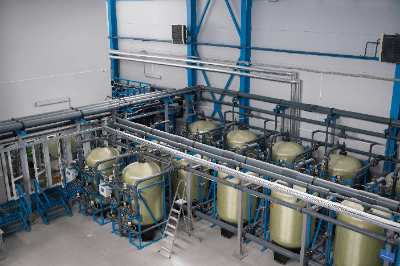What Is a Purification System?

A purification system is a device that removes undesirable substances from gases and liquids to prevent them from escaping to the next process or outside or to maintain or improve the environment itself.
There are various types of purification systems. For example, some systems physically remove target substances by collecting and adsorbing them with a filter or similar device. Other types include those that decompose target substances by inducing them into a high-temperature environment or an environment where a catalyst exists and those that detoxify target substances by supplying substances such as photocatalysts with sterilizing or oxidizing effects.
Applications of Purification Systems
Purification systems are often used to purify liquids or gases. The most common purification systems used to purify liquids are those used for household and commercial water treatment. The most familiar examples are water purifiers and water tank filters, which collect undesirable substances and add disinfectants as needed to maintain water quality.
Another typical example of a purification system used to purify gases is an automobile exhaust gas purification system. In the purification system for automobile exhaust, harmful substances generated when fuel is burned are decomposed into harmless substances under the presence of a catalyst. This purification system allows the harmless exhaust to be discharged into the atmosphere, thereby preventing any impact on the atmosphere.
Principle of Purification Systems
The principle of the purification system depends on the purification mechanism. Here, we will explain the Purification System used for water purification and the gas purification system used for the purification of automobile exhaust gases.
1. Water Purification System Using Activated Carbon Filters
The purification system used for water purification generally uses a filter made of activated carbon to purify water. When water is passed through an activated carbon filter, particles of undesirable substances in the water are adsorbed on the surface of the activated carbon due to the gravitational force (van der Waals force) from the surface of the activated carbon. The adsorbed particles are drawn into the pores of the activated carbon surface by capillary action, thus purifying the water.
In the case of this purification system, the fineness of the filter made of activated carbon can be adjusted by adjusting the size of the pores on the surface of the activated carbon. Therefore, if the particle size of the substance to be collected is known, the type of substance to be collected can be changed by setting the fineness of the filter as desired.
2. Water Purification System Using Ion Exchange Membrane
In the production of pure water, it is necessary to remove salt components such as calcium, sodium, and chloride from the water. These salt components exist in water as ions. Therefore, positively or negatively charged ion exchange membranes can be used as filters to adsorb and remove cations or anions for purification.
Whether using activated carbon filters or ion-exchange membranes, the contact area of the liquid is increased to improve adsorption efficiency.
3. Gas Purification System
Purification systems used to purify automobile exhaust gases, for example, utilize a catalyst. In a purification system using a catalyst, the target liquid or gas is brought into contact with the catalyst to render it harmless. In an automobile exhaust gas purification system, gases generated by combustion are introduced under a three-way catalyst to oxidize CO, which is a harmful component, to CO2 and hydrocarbons to CO2 and H2O, while NOx is reduced to N2 and O2 to render it harmless.
Even when a catalyst is used, it is necessary to devise a way to increase the contact area of the gases to improve the efficiency of the reaction.
Other Information on Purification Systems
1. Purification System for Water Tanks
One of the most familiar purification systems around us is the aquarium purification system. It is an indispensable equipment for aquariums that keep tropical fish and other aquatic organisms. There are three main methods of aquarium purification
Physical Filtration
Physical filtration captures tropical fish feces, food scraps, dead and decomposed aquatic plants, and other debris with a net, sponge, or other large-mesh material. The goal is to remove enough debris to be visible.
Chemical Filtration
Chemical filtration removes invisible debris from the water using materials such as ion exchange resins, zeolite, and activated carbon. These materials have microscopic holes in them that absorb debris and remove it from the water.
Biofiltration
In biological filtration, bacteria and other microorganisms work to decompose organic and toxic substances in the water and clean the water. It is an especially important filtration method for aquariums because it detoxifies highly toxic ammonia and nitrite, which cannot be removed by physical or chemical filtration.
2. How to Make Your Purification System
This section describes a homemade water purification system that can be made with items that are available around you. However, although this purification system can purify water, it is not potable water and should not be drunk. You will need the following materials
- Empty plastic bottles (about 2 liters)
- Cloth (hand towel, etc.)
- Tissue
- Pebbles, jari, activated charcoal, sand
The purification system removes small debris gradually from large debris in a process of purification. Therefore, hollow out the bottom of the PET bottle with the cap on, cap side down, and put in the materials from the top in the following order.
- Tissue
- Pebbles
- Gravel
- Activated charcoal
- Sand
- Cloth
In other words, from the cap side, they are stacked in the following order: tissue, pebbles, gravel, activated charcoal, sand, and cloth. Purification is done by removing the cap and slowly pouring muddy water from the bottom of the hollowed-out PET bottle. Then, impurities are collected by the materials inside in order of size, and the purified water slowly flows out from the mouth.